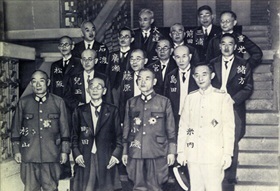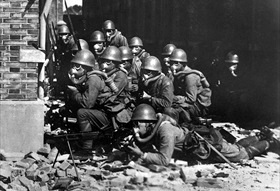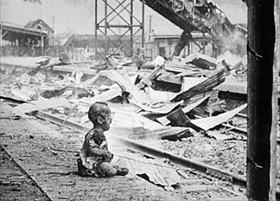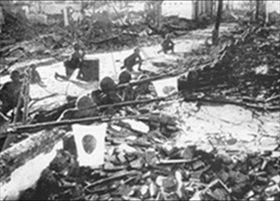CHINESE TRY OUSTING JAPANESE FROM SHANGHAI
Shanghai, China · August 13, 1937
The Battle of Shanghai began on this date in 1937. It was the first major battle of World War II (the European conflict erupted two years later), and it eventually involved nearly one million combatants. When hostilities broke out, Gen. Hajime Sugiyama, Minister of War in the Imperial Japanese Army from 1937 to 1944, advised Emperor Hirohito (posthumously referred to as Emperor Shōwa) that the Japanese Army would vanquish China “in about three months.” “We’ll send large forces, smash them in a hurry, and get the whole thing over with quickly,” Sugiyama predicted. The “three-month war” continued for eight years, one month, three weeks, and five days and cost 20 million Chinese lives, 15 million casualties, and created 95 million refugees. On the Japanese side, their armed forces suffered between 2.2 and 3.2 million casualties.
Following Japan’s occupation of Beijing (Peking) in July 1937, the Battle of Shanghai began when Chiang Kai-shek’s numerically superior National Revolutionary Army tried eradicating Japanese troops in downtown Shanghai. In a bid to rescue their garrison, the Japanese launched amphibious landings north of the city and the two armies fought a Stalingrad-type house-to-house battle, with the Japanese sometimes employing chemical weapons, as other Japanese elements gained control of the surrounding region. In the face of these flanking maneuvers Nationalist soldiers retreated toward their capital at Nanjing (Nanking).
The conquest of Shanghai, China’s second largest city, ended on November 26, 1937, with a loss of 270,000 people killed and over 100,000 injured or missing on both sides. The ferocity and tenacity shown by the Chinese shocked Japan’s military leaders, who had hoped for a quick victory for the 300,000 troops who had been engaged in combat operations. The Battle of Shanghai signified not just some “incident” against “bandits,” terms the Japanese expansionists had used previously to downplay their country’s aggression in China; rather, it opened a new chapter of all-out war between the two countries (the Second Sino-Japanese War), a chapter rudely closed in August 1945 by a third party to the conflict (the United States) after it had incinerated most of the aggressor nation’s major cities and wiped two more off the map.
[amazon_carousel widget_type=”ASINList” width=”600″ height=”200″ title=”Recommended Reading” market_place=”US” shuffle_products=”False” show_border=”False” asin=”0764339567,161200167X,0804792070,061889425X,156324246X,0842051538,1874622213,0465068367,0521144108,0786714840″ /]
Battle of Shanghai, August 13 to November 26, 1937
 |  |
Left: Hajime Sugiyama (left in first row), as Minister of War in the cabinet of Prime Minister Kuniaki Koiso (third from left in front row), July 22, 1944. (Koiso was Gen. Hideki Tōjō’s replacement.) In early September 1941, on the verge of the war with the United States and Great Britain, Emperor Hirohito severely berated Sugiyama for having predicted in 1937 that the Japanese invasion of China would be completed within three months, and he challenged Sugiyama over his confidence in a quick victory over the Western powers—a classic case of lessons not learned. Ten days after the surrender of Japan, after finishing preparations for the final dissolution of the Imperial Japanese Army as dictated by the victorious Allied Powers, Sugiyama committed suicide by shooting himself four times in the chest with his service revolver.
![]()
Right: Japanese soldiers wearing gas masks and rubber gloves during a chemical attack in the Battle of Shanghai (August 13, 1937, to November 26, 1937). The Japanese Army frequently used chemical weapons during the war in China. Indeed, soldiers were authorized to use chemical weapons on specific orders of Emperor Hirohito himself, transmitted by the Imperial General Headquarters through Gen. Sugiyama or another general on the Imperial Japanese Army General Staff.
 |  |
Left: This terrified baby was one of the only human beings left alive in Shanghai’s South Railway Station after the Japanese bombed it on August 28, 1937. Taken a few minutes after the Japanese air attack, this black-and-white photograph, titled “Bloody Saturday,” was published widely in September and October 1937 and in less than a month had been seen by more than 136 million viewers. One of the most memorable war photographs ever published, the image stimulated an outpouring of Western anger against Japanese violence in China.
![]()
Right: Japanese troops in the ruins of Shanghai, 1937. During the eight-year Second Sino-Japanese War (1937–1945), the Japanese military fielded 4.1 million men and enjoyed the services of 900,000 Chinese collaborators. Facing the enemy were 5.6 million Nationalist and Communist Chinese soldiers. Granted its imprecision, of the 1,130,000 Japanese soldiers estimated to have died during World War II, 447,000 (or 39 percent) died in China.
“The Battle of China” (1944), Part of the U.S. Government’s Morale-Building Series “Why We Fight,” Directed by Frank Capra
![]()

 History buffs, there is good news! The Daily Chronicles of World War II is now available as an ebook for $4.99 on Amazon.com. Containing a year’s worth of dated entries from this website, the ebook brings the story of this tumultuous era to life in a compelling, authoritative, and succinct manner. Featuring inventive navigation aids, the ebook enables readers to instantly move forward or backward by month and date to different dated entries. Simple and elegant! Click
History buffs, there is good news! The Daily Chronicles of World War II is now available as an ebook for $4.99 on Amazon.com. Containing a year’s worth of dated entries from this website, the ebook brings the story of this tumultuous era to life in a compelling, authoritative, and succinct manner. Featuring inventive navigation aids, the ebook enables readers to instantly move forward or backward by month and date to different dated entries. Simple and elegant! Click 











